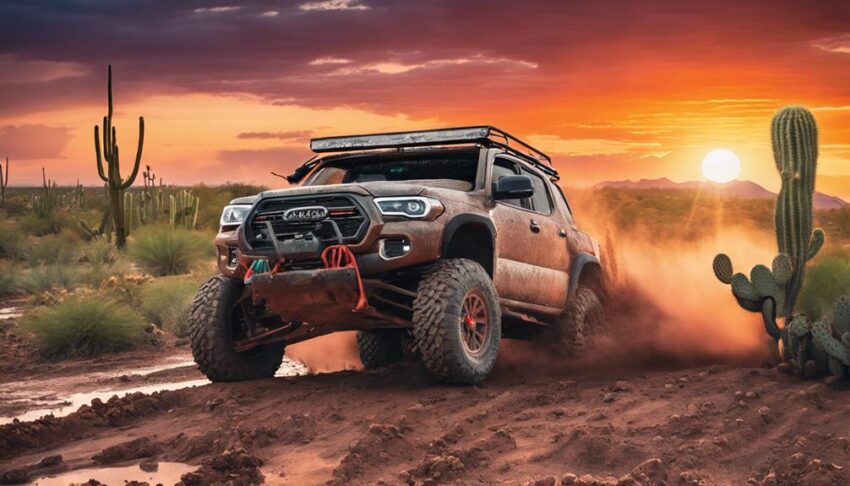If you're tackling the challenging terrains around McAllen, selecting the right 4×4 winch is vital for off-road safety and recovery. Look for a winch with a weight capacity that exceeds your vehicle's weight, typically between 8,000 to 12,000 pounds. Consider features like line type—synthetic for lightness or steel for durability—and ensure it has a suitable waterproof rating. Brands like Warn, Smittybilt, and Superwinch are known for their reliability. Proper installation and regular maintenance keep your winch performing at its best. For even more effective off-roading, explore essential accessories and troubleshooting tips that can enhance your experience.
Key Takeaways
- Top Brands: Consider reputable brands like Warn, Smittybilt, and Superwinch for reliable off-road winching performance in McAllen's challenging terrains.
- Weight Capacity: Choose a winch with a weight capacity exceeding your vehicle's weight, ideally between 8,000 to 12,000 pounds for optimal recovery.
- Line Type: Select between synthetic lines for lightweight portability and steel lines for enhanced durability, depending on your off-roading needs.
- Safety Features: Look for waterproof ratings, effective braking systems, and quality construction to ensure safety and longevity during winch operations.
- Essential Accessories: Enhance your winching experience with accessories like snatch blocks, winch dampers, and remote control kits for added convenience and safety.
Importance of Winches for Off-Roading
When you venture off the unconventional path, having a winch on your vehicle isn't just a luxury—it's a necessity. Off-road accessories like winches play an essential role in ensuring vehicle recovery when you encounter challenging terrains like mud, sand, or rocky obstacles. This powerful tool can pull vehicles weighing between 8,000 to 12,000 pounds, making it suitable for most off-road applications.
The importance of a winch goes beyond mere convenience; it greatly enhances your safety and self-recovery capabilities. If you find yourself stuck in a precarious situation, a winch allows you to extricate your vehicle without relying on others. This independence not only boosts your confidence but also guarantees you can enjoy your off-road adventures without fear of getting stranded.
However, it's crucial to remember that a winch requires regular maintenance and inspection to function at its best. Keeping your winch in top condition ensures that, when you need it most, it'll perform effectively, providing a reliable means of vehicle recovery. So, equip your vehicle with a winch and embrace the freedom of off-roading, knowing you've got the right tools for any situation.
Key Features to Consider
Choosing the right winch is vital for ensuring that your off-road adventures remain safe and enjoyable. When it comes to winch selection, there are several key features you should consider.
| Feature | Importance |
|---|---|
| Weight Capacity | Make sure it can handle your vehicle's weight. |
| Line Type | Synthetic is lighter; steel provides durability. |
| Waterproof Rating | Shields against the elements during use. |
| Braking System | Reliable brakes prevent accidents and slips. |
| Construction Quality | Sturdy materials extend the winch's lifespan. |
| Control Mechanism | Easy controls guarantee smooth operation. |
| Motor Type | Choose between DC or AC motors for efficiency. |
| Gear Ratio | Impacts pulling power and speed of operation. |
Don't forget to evaluate additional winch features like wireless remote controls and thermal overload protection. These enhancements not only improve functionality but also contribute to your overall safety during off-road excursions. Lastly, opt for winches from reputable brands with solid warranties, as positive user reviews can greatly impact your satisfaction and reliability.
Top Winch Brands for McAllen
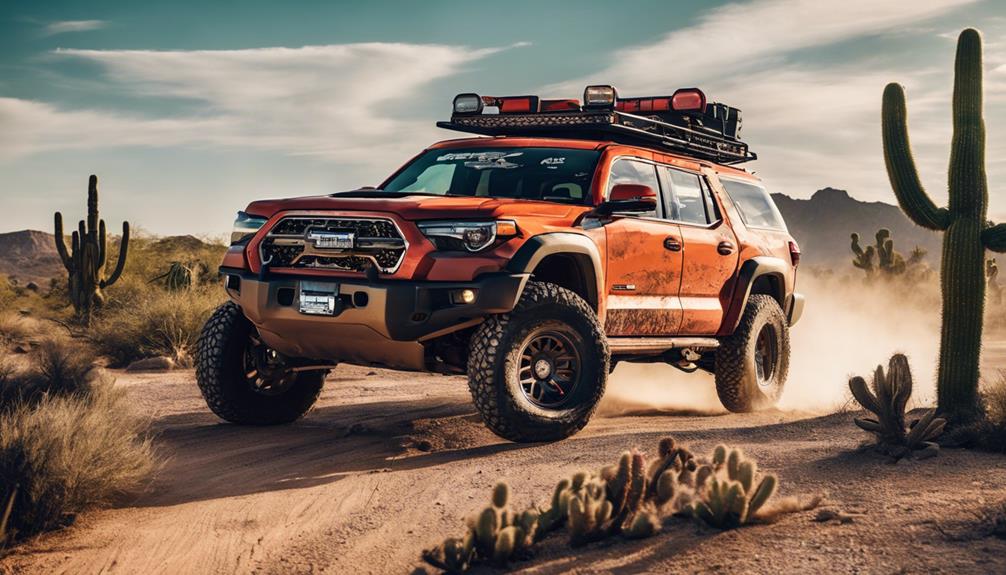
For McAllen off-roaders, selecting a winch from a reputable brand can make a significant difference in performance and reliability. When you're out in the rugged terrain, you want gear that you can trust. Warn is a standout choice, renowned for its durability and reliability in challenging off-road conditions. Their winches are built to withstand the elements, ensuring you're ready for anything the wild throws at you.
Smittybilt offers a compelling option for off-road enthusiasts seeking a balance between performance and affordability. With a variety of models available, you can find a Smittybilt winch that suits your budget without sacrificing quality.
Superwinch is another brand that has earned the trust of McAllen off-roaders. Known for their range of winch options, they cater to various vehicle weights and specific needs, making it easy for you to find the perfect fit for your rig.
When choosing a winch, consider these top brands. They provide the reliability and performance that off-road enthusiasts need for their adventures in the rugged McAllen landscape.
Winch Ratings and Capacities
How do you determine the right winch rating for your off-roading needs? Start by understanding that winch ratings typically range from 8,000 lbs to 12,000 lbs, which reflects their pulling capacity. You should select a winch with a rating that exceeds your vehicle's weight for peak performance. This ensures that you have enough power to handle unexpected challenges during off-road operations.
Next, consider additional factors like line speed, motor efficiency, and gear ratio when evaluating winch capacities. A winch with a higher line speed can save you time during recovery, while a more efficient motor can provide superior performance under load. Additionally, a favorable gear ratio can enhance your winch's pulling power and reduce strain on the system.
Winch Installation Best Practices
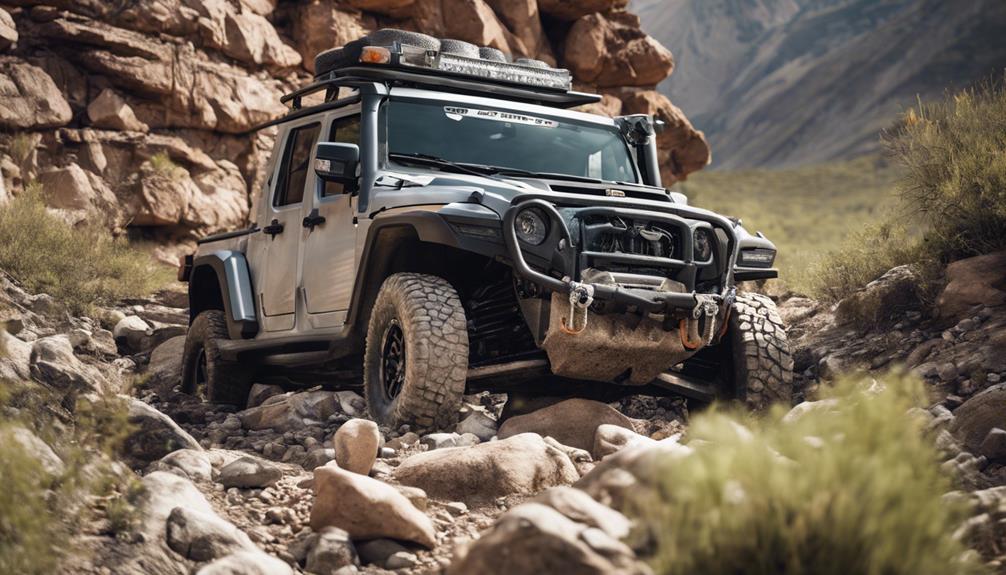
Installing a winch properly is essential for guaranteeing reliable performance during off-road adventures. To start, always use the manufacturer's template for drilling mounting holes. This guarantees the winch aligns correctly and avoids unnecessary stress on your vehicle. When it's time for bolts tightening, make certain to follow the manufacturer's specifications. This will prevent any issues that could arise during operation.
Next, double-check all electrical connections. Verify they're secure and free from damage or corrosion, as this can affect the winch's performance. After installation, it's wise to test your winch under a light load. This not only confirms that it operates smoothly but also gives you a chance to familiarize yourself with the controls and functions.
Here's a quick checklist to follow during your winch installation:
| Task | Details |
|---|---|
| Drill Holes | Use the manufacturer's template for accuracy |
| Bolts Tightening | Follow specifications to prevent issues |
| Check Electrical Connections | Ensure they're secure and corrosion-free |
| Test Winch | Operate under a light load for confirmation |
| Familiarize with Controls | Understand functionality for safe operation |
Maintenance Tips for Longevity
To optimize your winch lasts, it's important to establish a regular inspection schedule. Make sure to lubricate moving parts and clean the unit frequently to protect against wear and environmental damage. Additionally, keeping an eye on the winch line for any signs of wear will help you avoid accidents and maintain peak performance.
Regular Inspection Schedule
Maintaining your winch is in top shape involves a regular inspection schedule that addresses both its mechanical components and the winch line. Start by examining the winch components for any signs of wear or damage, particularly the gear system and motor. Look for frayed wires, rust, or corrosion, as these can compromise performance and safety.
Next, pay close attention to the winch line. Inspect it for any abrasions, kinks, or cuts that could lead to failure during an off-road recovery. A strong winch line is critical for your safety and the effectiveness of your off-road vehicle.
Make it a habit to periodically test the winch under load. This not only guarantees proper function but also confirms that it's ready to tackle future challenges. Following the manufacturer guidelines for maintenance intervals is crucial for extending your winch's longevity.
Lastly, be proactive in cleaning your winch and safeguarding it from environmental elements. Keeping your equipment in prime condition will assure you have the freedom to explore without worries, knowing your winch is reliable when you need it most.
Lubrication and Cleaning Tips
Keeping your winch in peak condition hinges on regular lubrication and cleaning, two essential tasks that prevent corrosion and guarantee smooth operation. Start by selecting a high-quality lubricant designed for winch components; this safeguards that gears, bearings, and other moving parts remain well-protected from rust and wear. Apply the lubricant according to the manufacturer's guidelines, focusing on areas that experience the most friction.
Next, clean your winch regularly to remove dirt, debris, and grime that can lead to premature wear. Use a soft brush and a mild detergent solution to scrub the winch's exterior and components. Be sure to rinse thoroughly and dry the parts to avoid moisture buildup.
As you clean and lubricate, inspect your winch for any signs of wear or damage. Addressing issues promptly can save you from costly repairs down the road. Establish a maintenance schedule tailored to your off-roading habits—this will help keep your winch in top condition, safeguarding it performs reliably when you need it most. For the best off-road experience, don't forget to check out the various parts and accessories in McAllen to enhance your winching setup.
Safety Precautions for Winch Use
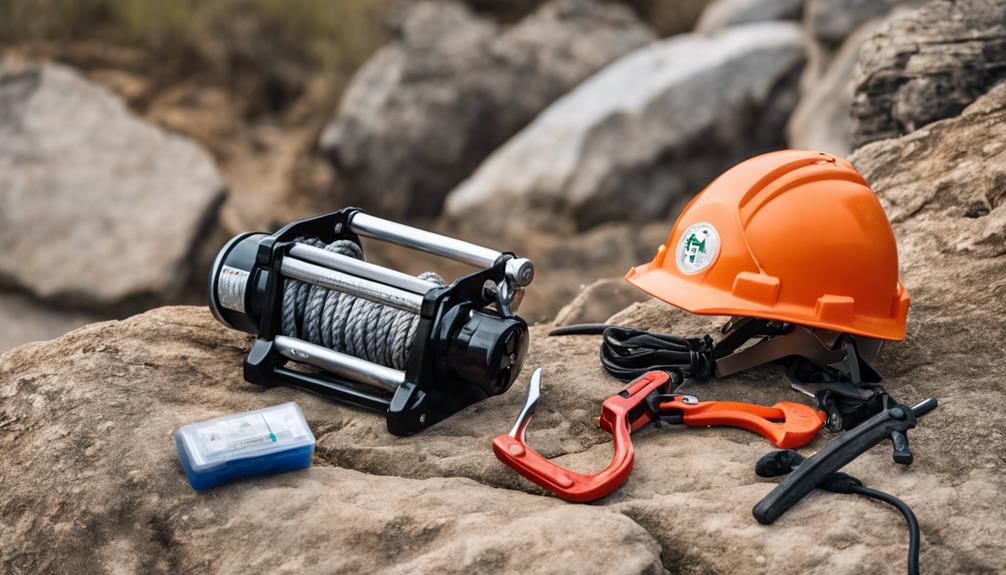
When using a winch, it's important to wear appropriate safety gear, including gloves and eye protection, to protect yourself from potential hazards. Always maintain a safe distance from bystanders during operation, as winching can pose risks to those nearby. Additionally, following proper winch operation techniques guarantees not only your safety but also the longevity of your equipment.
Proper Safety Gear
Operating a winch demands a keen awareness of safety gear to protect yourself from potential hazards. When engaging in proper winch operation, always wear gloves to shield your hands from sharp edges and cable slippage. Eye protection is essential; flying debris from a snapped cable could lead to serious injuries. Heavy-duty clothing is necessary, providing an additional barrier against any unforeseen accidents.
Incorporating a winch damper or blanket into your setup is a smart move. This crucial piece of winch safety gear helps absorb energy in the event of cable breakage, reducing the risk of recoil that can cause severe injuries. Before you start, make sure the winch hook is securely fastened to the anchor point and adequately rated for the load you're handling.
Regular inspection of the winch components is indispensable. Look for wear, damage, or any signs of fatigue to guarantee safe and efficient operation. Keeping these safety measures in mind not only protects you but also enhances your off-roading experience, allowing you to embrace the freedom of adventure with confidence.
Bystander Distance Awareness
Winch operations can be exciting yet risky, making bystander distance awareness important for safety. When you're using a winch, it's vital to maintain a safe distance of at least 1.5 times the winch cable length. This guideline helps mitigate the potential dangers associated with snap-back, which can occur if the winch cable fails or if there's unexpected movement.
Bystanders should always stand clear of the winch cable's path to avoid serious injury. Educating those nearby about the risks of standing too close is crucial. When people understand the dangers, they can better appreciate the need for distance and remain alert during operations.
Winch Operation Techniques
Maintaining a safe distance during winch operations is just the beginning; understanding the techniques and precautions for effective winching is equally significant. First, always wear appropriate safety gear, including gloves and eye protection. This safeguards you from potential injuries caused by flying debris or a broken winch line.
Next, familiarize yourself with the winch operation manual and safety guidelines before you start. This knowledge is vital for safe handling and ensures you're prepared for any situation. Effective communication is key during winching; use proper hand signals or coordinate with a spotter to minimize risks.
Avoid sudden jerking movements while winching, as these can damage your vehicle or the winch itself. Instead, opt for smooth, gradual pulls to effectively manage the load. Also, keep a safe distance from the winch line, as line breakage can occur unexpectedly, posing a significant threat to anyone nearby.
Winch Accessories and Add-Ons
Often disregarded, winch accessories and add-ons play a crucial role in enhancing the performance and safety of your off-road escapades. If you wish to maximize your winching capabilities, consider investing in these essential parts:
- Snatch Blocks: These are priceless for boosting pulling power and changing the direction of your winch line. With a snatch block, you can effectively double your winching capacity, making challenging pulls more manageable.
- Winch Covers: Safeguard your winch from dust, water, and debris with a sturdy cover. This simple accessory ensures your winch remains in prime condition, prolonging its lifespan and performance during off-road adventures.
- Tree Savers: When securing to trees, utilizing a tree saver minimizes environmental impact. This accessory safeguards both the tree and your vehicle, allowing you to winch securely without harming nature.
Moreover, consider winch dampers for safety, remote control kits for convenience, and always prioritize the right accessories to enrich your off-road experience. By equipping your winch with these accessories, you'll be prepared for any challenge the trail presents.
Troubleshooting Common Winch Issues
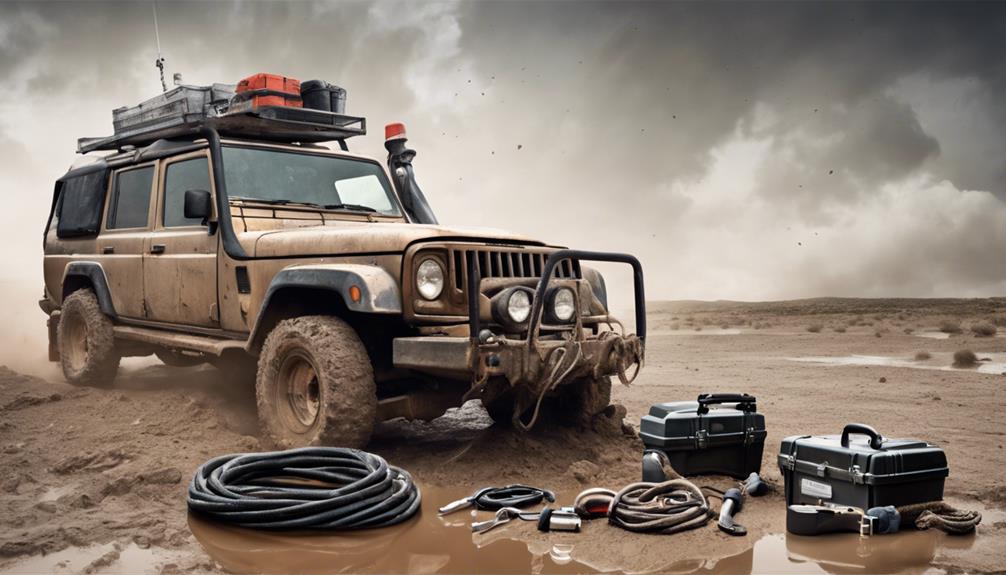
When you're out on the trails, common winch failures like motor overheating or solenoid issues can quickly derail your off-roading experience. Diagnosing these problems involves examining electrical connections, testing the motor, and looking for any signs of cable or rope damage. Addressing these concerns promptly not only guarantees your winch operates smoothly but also extends its lifespan.
Common Winch Failures
Neglecting routine maintenance can lead to a range of common winch failures that may hinder your off-roading adventures. Understanding these issues is essential for ensuring your winch operates effectively. Here are three common failures you should be aware of:
- Overheating: This often occurs due to prolonged use without breaks or inadequate power supply. If you notice your winch getting excessively hot, it's a sign to stop and cool it down.
- Motor Failure: Poor quality materials can lead to motor malfunctions. Regular inspections can help identify any wear and tear before it leads to complete failure.
- Solenoid Problems: These electrical components can fail due to moisture or corrosion. Ensuring your solenoids are clean and dry is important for reliable operation.
Diagnosis and Solutions
Understanding common winch failures is only the first step in ensuring your winch operates smoothly. For effective diagnosis of winch issues, you should pay attention to symptoms like overheating, slow operation, or unusual noises. These signs often indicate underlying problems that need addressing to maintain your winch's performance.
To tackle overheating, check your electrical connections for any loose or corroded wiring. If your winch operates slowly, it might be due to inadequate power supply or a clogged motor. Clean and lubricate components regularly to reduce friction and enhance efficiency. Additionally, if you hear unusual noises, inspect the clutch setting; an improper adjustment could lead to gear strain.
Consult your winch manual for tailored troubleshooting steps and recommended solutions specific to your model. Understanding the root cause of these winch issues can substantially reduce the risk of future malfunctions. Regular maintenance and timely repairs can extend the lifespan of your winch, ensuring it's always ready for your off-road adventures. Embrace the freedom of the great outdoors, knowing your winch is in top working condition.
Real-Life Recovery Stories
Real-life recovery stories underscore the critical role a reliable winch plays in off-road adventures, often turning potential disasters into triumphant recoveries. Whether you're tackling mud, sand, or rocky paths, having a winch can make the difference between being stranded and continuing your journey. Here are three notable examples:
- Mud Pit Rescue: An off-roader got stuck in a deep mud pit during a weekend trip. With a winch securely anchored to a tree, they pulled themselves free, preventing an embarrassing night in the wilderness.
- Steep Incline Recovery: On a rugged terrain climb, another enthusiast's vehicle slid sideways, teetering dangerously. Using a winch to stabilize and pull the vehicle back onto the path, they avoided potential rollovers and damage.
- Group Coordination: During a challenging terrains excursion, a group of friends used winches in tandem to recover a vehicle that had sunk into soft earth. The teamwork not only saved the day but also highlighted the importance of having multiple reliable winches available.
These stories illustrate how winches are essential tools for any off-roader, providing freedom and security on the most challenging adventures.
Frequently Asked Questions
What Is the Average Cost of a Quality 4×4 Winch?
The average cost of a quality 4×4 winch ranges from $300 to $1,500, depending on the installation process, maintenance requirements, and warranty coverage. It is crucial to take into account these factors for peak performance and reliability.
How Do I Determine the Right Winch Size for My Vehicle?
To determine the right winch size, consider your vehicle's weight capacity, guarantee compatibility with your vehicle type, and evaluate the power source. These factors help optimize performance for your off-road adventures and recovery needs.
Can I Use a Winch for Purposes Other Than Off-Roading?
Did you know that over 30% of winch users employ them for home projects? You can definitely use a winch for towing assistance or in emergency situations, proving its versatility beyond just off-roading.
What Are the Legal Regulations for Winch Use in Mcallen?
In McAllen, you'll need to follow safety guidelines and check permit requirements for winch use. Address liability concerns by ensuring your equipment's properly maintained. Being informed helps you enjoy off-roading while staying compliant.
How Do Weather Conditions Affect Winch Performance?
Weather conditions can impact winch performance. For best results, you should follow maintenance tips, adhere to safety precautions, and be mindful of common issues like freezing temperatures or excessive mud that can impair functionality.
